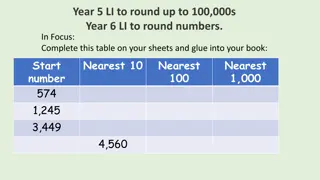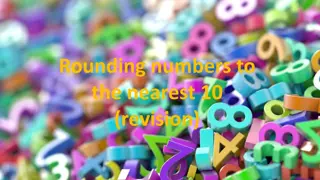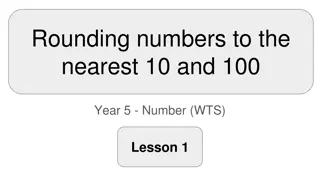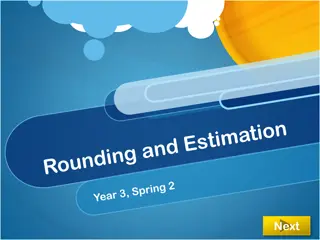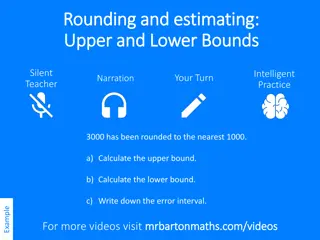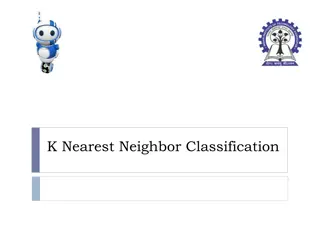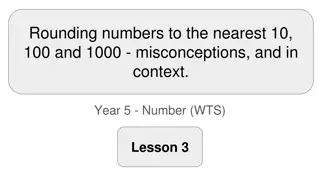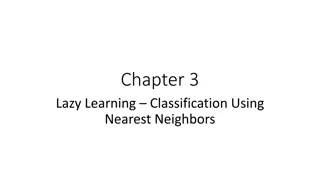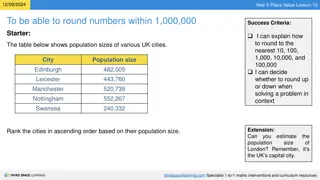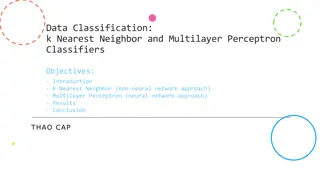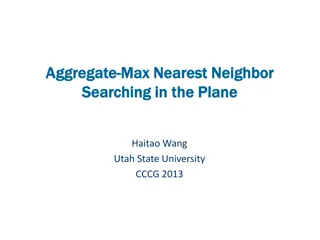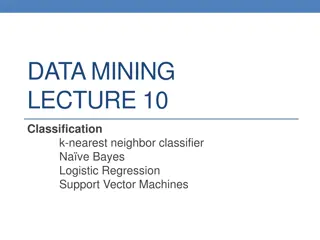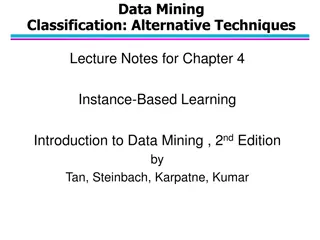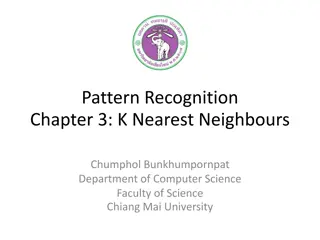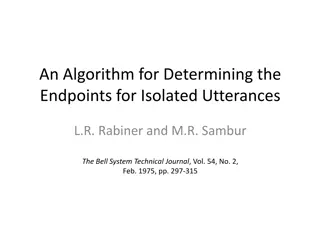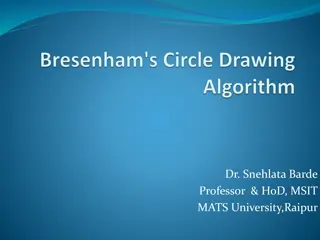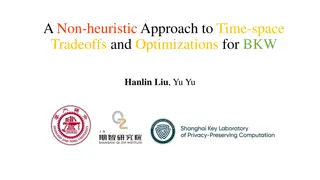Algorithm Analysis
Algorithm analysis involves evaluating the efficiency of algorithms through measures such as time and memory complexity. This analysis helps in comparing different algorithms, understanding how time scales with input size, and predicting performance as input size approaches infinity. Scaling analysi
1 views • 30 slides
Understanding Booth's Algorithm for Binary Integer Division
Learn about Booth's Algorithm and how it facilitates binary integer division. Discover key points to remember when using the algorithm, steps to initiate the process, and a detailed example to illustrate the multiplication of two operands using Booth's Algorithm.
1 views • 42 slides
Rounding Numbers and Identifying Nearest Multiples Practice Sheets
Practice rounding numbers to the nearest 10, 100, and 1,000, as well as identifying the nearest multiples of 10,000, 100,000, and 1,000,000. Complete tables, match numbers to their nearest values, and understand the concept of rounding within different ranges. Improve your math skills with these eng
0 views • 14 slides
Understanding Stable Matchings and the Gale-Shapley Algorithm
The concept of stable matchings is explored, along with the Gale-Shapley algorithm for finding them efficiently. Key ideas and steps of the algorithm are explained, supported by visuals. The process, examples, and observations related to the algorithm's effectiveness are discussed, highlighting the
1 views • 29 slides
Performance of Nearest Neighbor Queries in R-trees
Spatial data management research focuses on designing robust spatial data structures, inventing new models, constructing query languages, and optimizing query processing. This study explores the estimation of query performance and selectivity, specifically in R-trees, for efficient access planning.
1 views • 32 slides
Ricart and Agrawala's Algorithm for Mutual Exclusion
The Ricart-Agrawala Algorithm is a distributed system algorithm for achieving mutual exclusion without the need for release messages, developed by Glenn Ricart and Ashok Agrawala. The algorithm involves processes sending timestamped requests to enter a critical section, with careful handling of repl
1 views • 16 slides
Understanding Algorithm Efficiency Analysis
In this chapter, Dr. Maram Bani Younes delves into the analysis of algorithm efficiency, focusing on aspects such as order of growth, best case scenarios, and empirical analysis of time efficiency. The dimensions of generality, simplicity, time efficiency, and space efficiency are explored, with a d
1 views • 28 slides
Understanding Lamport Algorithm for Mutual Exclusion
Lamport Algorithm, presented by Prafulla Santosh Patil, is a permission-based algorithm utilizing timestamps to order critical section requests and resolve conflicts. It employs three types of messages: REQUEST, REPLY, and RELEASE, where each site manages a queue to store requests. By ensuring commu
0 views • 15 slides
Mastering Rounding Numbers to the Nearest 10: A Comprehensive Guide
Dive into the world of rounding numbers to the nearest 10 with this informative guide. Learn the steps to round any number, including those with multiple digits, and practice your skills with interactive examples. Discover a helpful rhyme to remember the rounding rules and explore scenarios when rou
2 views • 9 slides
Rounding Numbers to the Nearest 10 and 100 for Year 5 - Lesson 1
In this lesson, students will learn how to round numbers to the nearest 10 and 100. Key concepts covered include identifying the nearest multiple to a number, deciding whether to round up or down, and exploring possibilities when rounding. The lesson builds upon Year 3 and 4 knowledge and emphasizes
2 views • 14 slides
Digital Differential Analyzer (DDA) Algorithm in Computer Graphics
In computer graphics, the Digital Differential Analyzer (DDA) Algorithm is utilized as the basic line drawing algorithm. This method involves interpolation of variables between two endpoints to rasterize lines, triangles, and polygons efficiently. The algorithm requires inputting coordinates of two
0 views • 9 slides
Sharpen Your Rounding Skills with Fun Quizzes!
Practice rounding skills with engaging quizzes on rounding two and three-digit numbers to the nearest 10. Test yourself with various numbers like 13, 43, 67, and 114 to see how well you can round to the nearest 10. Enjoy the challenge and improve your math accuracy!
1 views • 25 slides
Understanding Rounding and Estimating: Upper and Lower Bounds Example
Explore how to determine upper and lower bounds after rounding numbers to the nearest 1000 or 100. Learn how to calculate the error intervals and practice your skills with provided examples. Gain a clear understanding of rounding to the nearest whole number and how to identify boundaries in estimati
1 views • 4 slides
Understanding Nearest Neighbor Classifiers in Machine Learning
Nearest Neighbor Classifiers are a fundamental concept in machine learning, including k-Nearest Neighbor (k-NN) Classification. This method involves assigning a test sample the majority category label of its k nearest training samples. The rule is to find the k-nearest neighbors of a record based on
0 views • 32 slides
Understanding Rounding to the Nearest Multiples: Year 5 Number Lesson
Explore rounding numbers to the nearest 10, 100, and 1000 in a Year 5 Number lesson. Identify misconceptions, learn to round up or down, and master possibilities when rounding. Practice rounding fluency and test your skills with examples and answers provided.
1 views • 11 slides
Lazy Learning Classification Using Nearest Neighbors
Lazy Learning Classification Using Nearest Neighbors explores the concept of classifying data by grouping it with similar neighbors. The chapter delves into the characteristics of nearest neighbor classifiers, their applications in various fields, and the suitability of using them based on data comp
0 views • 44 slides
Grey Wolf Optimizer: A Nature-Inspired Optimization Algorithm
The Grey Wolf Optimizer algorithm is based on the social hierarchy of grey wolves in the wild. Inspired by the pack behavior of grey wolves, this algorithm utilizes alpha, beta, and delta solutions to guide the optimization process. The hunting phases of tracking, pursuing, and attacking prey mimic
3 views • 16 slides
Place Value and Rounding Lesson for Year 5 Students
In this lesson on place value and rounding for Year 5 students, learners practice rounding numbers within 1,000,000. They are guided to round to the nearest 10, 100, 1,000, 10,000, and 100,000, and make decisions on rounding up or down. The lesson includes ranking UK cities by population size, estim
0 views • 23 slides
Emergency Paediatric Tracheostomy Management Algorithm
Emergency Paediatric Tracheostomy Management Algorithm provides a structured approach for managing pediatric patients requiring tracheostomy in emergency situations. The algorithm outlines steps for assessing airway patency, performing suction, and changing the tracheostomy tube if necessary. It emp
0 views • 4 slides
Development of Satellite Passive Microwave Snowfall Detection Algorithm
This study focuses on the development of a satellite passive microwave snowfall detection algorithm, highlighting the challenges in accurately determining snowfall using satellite instruments. The algorithm uses data from AMSU/MHS, ATMS, and SSMIS sensors to generate snowfall rate estimates, overcom
0 views • 20 slides
Understanding Euclid's Algorithm: An Ancient Approach to Finding Greatest Common Divisors
Euclid's Algorithm, dating back 2500 years, offers a simpler method to find the greatest common divisor (gcd) of two non-negative integers compared to traditional factorization. By iteratively applying a rule based on the gcd of remainders, it efficiently computes gcd values. The basis of the algori
0 views • 15 slides
Data Classification: K-Nearest Neighbor and Multilayer Perceptron Classifiers
This study explores the use of K-Nearest Neighbor (KNN) and Multilayer Perceptron (MLP) classifiers for data classification. The KNN algorithm estimates data point membership based on nearest neighbors, while MLP is a feedforward neural network with hidden layers. Parameter tuning and results analys
0 views • 9 slides
Searching for Nearest Neighbors and Aggregate Distances in Plane Algorithms
This overview discusses different algorithms related to nearest neighbor searching and aggregate distances in the plane. It covers concepts like aggregate-max, group nearest neighbor searching, applications in meeting location optimization, and previous heuristic algorithm work. Results include prep
0 views • 25 slides
Understanding Nearest Neighbor Classification in Data Mining
Classification methods in data mining, like k-nearest neighbor, Naive Bayes, Logistic Regression, and Support Vector Machines, rely on analyzing stored cases to predict the class label of unseen instances. Nearest Neighbor Classifiers use the concept of proximity to categorize data points, making de
0 views • 58 slides
Introduction to Instance-Based Learning in Data Mining
Instance-Based Learning, as discussed in the lecture notes, focuses on classifiers like Rote-learner and Nearest Neighbor. These classifiers rely on memorizing training data and determining classification based on similarity to known examples. Nearest Neighbor classifiers use the concept of k-neares
0 views • 13 slides
Understanding Locality Sensitive Hashing (LSH) for Nearest Neighbor Queries
Locality Sensitive Hashing (LSH) is a technique used to efficiently find nearest neighbors in high-dimensional spaces. By grouping similar points into the same hash bucket, LSH enables fast search for nearest neighbors, overcoming the curse of dimensionality. Variants include k-nearest neighbors and
0 views • 41 slides
Understanding K-Nearest Neighbours in Pattern Recognition
Explore the concepts of K-Nearest Neighbours (KNN) algorithm, its variants, and applications in pattern recognition. Learn about nearest neighbour based classifiers, prototype selection methods, and how the algorithm assigns class labels. Dive into examples and a detailed explanation of the algorith
0 views • 52 slides
GPU Accelerated Algorithm for 3D Delaunay Triangulation
Thanh-Tung Cao, Todd Mingcen Gao, Tiow-Seng Tan, and Ashwin Nanjappa from the National University of Singapore's Bioinformatics Institute present a GPU-accelerated algorithm for 3D Delaunay triangulation. Their work explores the background, related works, algorithm implementation, and results of thi
0 views • 24 slides
Machine Learning Techniques: K-Nearest Neighbour, K-fold Cross Validation, and K-Means Clustering
This lecture covers important machine learning techniques such as K-Nearest Neighbour, K-fold Cross Validation, and K-Means Clustering. It delves into the concepts of Nearest Neighbour method, distance measures, similarity measures, dataset classification using the Iris dataset, and practical applic
1 views • 14 slides
Cuckoo Search: A Nature-Inspired Optimization Algorithm
Cuckoo Search (CS) algorithm, developed in 2009, mimics the brood parasitism of cuckoo species and utilizes Lévy flights for efficient optimization. This algorithm has shown promise in outperforming other traditional methods like PSO and genetic algorithms. The behavior of cuckoos in laying eggs an
0 views • 25 slides
Ford-Fulkerson Algorithm for Maximum Flow in Networks
The Ford-Fulkerson algorithm is used to find the maximum flow in a network by iteratively pushing flow along paths and updating residual capacities until no more augmenting paths are found. This algorithm is crucial for solving flow network problems, such as finding min-cuts and max-flow. By modelin
0 views • 26 slides
3GPP Voting Rights Algorithm: Contiguous-3 Solution Evaluation
This evaluation delves into the advantages and disadvantages of the 3 Contiguous-3 solution within the 3GPP voting rights algorithm. It explores scenarios to test the algorithm's effectiveness in granting and revoking voting rights based on meeting attendance types. The evaluation includes diverse h
0 views • 10 slides
Introduction to Algorithm Analysis and Complexity in Computer Science
Algorithm analysis is crucial in determining the efficiency of programs by analyzing resource usage such as time and space. This involves comparing programs, understanding data structures, and evaluating algorithm performance. Efficiency is key as program execution time depends on various factors be
0 views • 66 slides
Bresenham Line Drawing Algorithm Explained with Examples
Bresenham Line Drawing Algorithm is a method used to generate points between starting and ending coordinates to draw lines efficiently. This algorithm involves calculating parameters, decision parameters, and iteratively finding points along the line. Two example problems are provided with step-by-s
0 views • 8 slides
Algorithm Strategies: Greedy Algorithms and the Coin-changing Problem
This topic delves into general algorithm strategies, focusing on the concept of greedy algorithms where locally optimal choices are made with the hope of finding a globally optimal solution. The discussion includes the nature of greedy algorithms, examples such as Dijkstra's algorithm and Prim's alg
0 views • 91 slides
Stable Matching Problem and Gale-Shapley Algorithm Overview
The content provides information on the stable matching problem and the Gale-Shapley algorithm. It covers the definition of stable matching, the workings of the Gale-Shapley algorithm, tips for algorithm implementation, and common questions related to the topic. The content also includes a summary o
0 views • 16 slides
Understanding Deutsch's Algorithm in Quantum Computing
Deutsch's Algorithm is a fundamental quantum algorithm designed to solve the problem of determining if a given function is constant or balanced. This algorithm leverages quantum principles such as superposition and entanglement to provide a more efficient solution compared to classical methods. By e
0 views • 17 slides
Algorithm for Determining Endpoints in Speech Recognition
This article discusses an algorithm proposed by L.R. Rabiner and M.R. Sambur in 1975 for determining endpoints in isolated utterances. The algorithm focuses on detecting word boundaries in speech through the recognition of silence, which can lead to reduced processing load and increased convenience,
0 views • 22 slides
Bresenham's Circle Drawing Algorithm Explained
Bresenham's Circle drawing algorithm is a fast and efficient method for drawing circles using integer arithmetic. It divides the circle into octants and selects the nearest pixel positions to create smooth arcs. This algorithm is widely used for graphics applications due to its speed and accuracy.
0 views • 15 slides
Time-space Tradeoffs and Optimizations in BKW Algorithm
Time-space tradeoffs and optimizations play a crucial role in the BKW algorithm, particularly in scenarios like learning parity with noise (LPN) and BKW algorithm iterations. The non-heuristic approach in addressing these tradeoffs is discussed in relation to the hardness of the LPN problem and the
0 views • 14 slides


